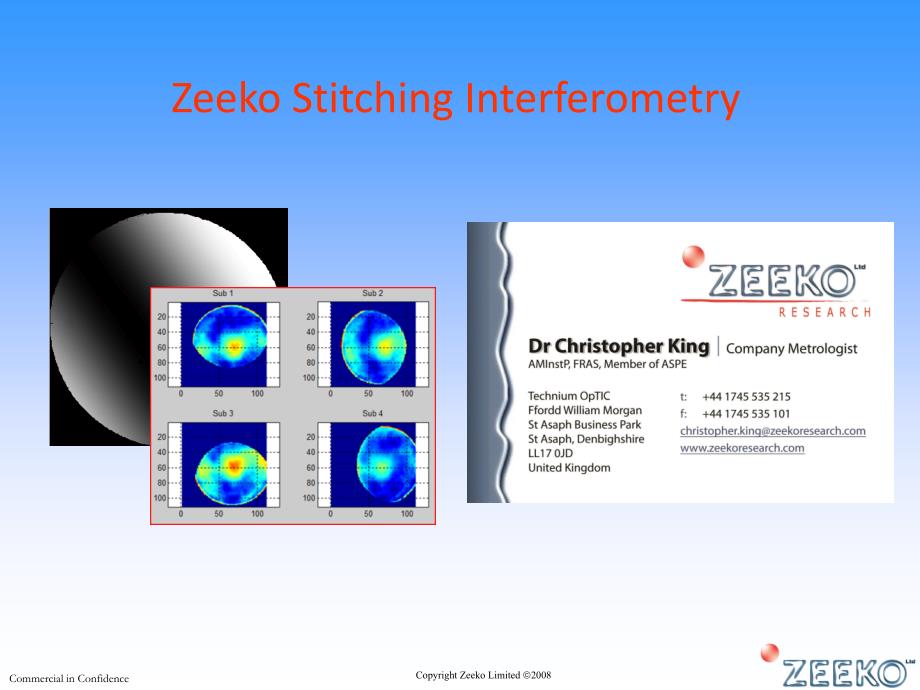 ZYGO干涉仪2
ZYGO干涉仪2



《ZYGO干涉仪2》由会员分享,可在线阅读,更多相关《ZYGO干涉仪2(32页珍藏版)》请在装配图网上搜索。
1、Click to edit Master title style,Click to edit Master text styles,Second level,Third level,Fourth level,Fifth level,Copyright Zeeko Limited,2008,Zeeko Stitching Interferometry,Commercial in Confidence,Why use stitching interferometry,Extend the aperture of an interferometer measure larger diameter p
2、arts,Enable measurements on high-NA convex parts,Can be used to extend the aspheric measuring range of an interferometer,Can be used to give increased spatial resolution,Can shorten the optical length of the interferometer cavity to reduce the effects of turbulence,Commercial in Confidence,Measuring
3、 Instruments,We measure the surfaces with respect to an optically or mechanically defined datum.,Profilometric techniques.,Optical(Interferometric)techniques.,I will concentrate on interferometry,Recipe for Stitching,We seek to join together several overlapping measurements of parts of a surface.,We
4、 need to minimize the discrepancy in the overlap areas,a minimization problem.,We must somehow transform the data in each measurement in a way that makes it fit the other measurements,without altering the overall form information in the data,We start by visualising the measurement process.,An exampl
5、e using a convex surface under test,We have a sub-aperture map on the surface to test,We then have a series of sub-apertures after the measurement,Summary of the stitching process,Measure first sub-aperture,Move to next position,Measure next sub-aperture,All done?,No,Yes,Generate a guess transformat
6、ion for each sub-aperture,Transform sub-apertures,Compute merit function,Merit function low enough?,Generate better guess,Form a new data set with all points,Filter data set,Use it!,Yes,No,Transformations,We must apply transformations to the data to stitch the measurement sets.,Use a matrix formalis
7、m we express the transformations required in a single matrix and use this in a least-squares optimization.,We have a point cloud of data for each measurement result:,Transformations(cont),We apply a transformation matrix to the points to give the new points,Only certain operations are allowed:,Linea
8、r translation,Polar rotation,Aberration correction,Tip,tilt,defocus,distortion and reference surface subtraction,A transformation looks like(excluding defocus):,A and B are the tip and tilt(shearing),(t,x,t,y,t,z,)are the linear translation components and,is the polar rotation angle.,Adding defocus
9、terms is more involved and involves computing a defocus coefficient for each data set difficult with non-circular apertures,and generally computationally intensive.,Measure first sub-aperture,Move to next position,Measure next sub-aperture,All done?,No,Yes,Generate a guess transformation for each su
10、b-aperture,Transform sub-apertures,Compute merit function,Merit function low enough?,Generate better guess,Form a new data set with all points,Filter data set,Use it!,Yes,No,Summary of the stitching process,Interferometer Imaging Distortion,OBJECT,BARREL,PINCUSHION,DISTORTED IMAGE,Interferometer Ima
11、ging Distortion,OBJECT,BARREL,PINCUSHION,DISTORTED IMAGE,Data manipulation,The acquired phasemaps are then corrected for,Residual aberrations(calibration of the reference wavefront,Scale(using base radius from cats eye),We are also working on reverse ray-tracing for more aspheric parts computing the
12、 interferograms that result from aspheric parts to aid the data manipulation,Stitching,The stitching proceeds by optimization.,The phasemaps are transformed against a merit function that minimizes the distances between the fiducials,When the best minimum is found,the data are stitched.,The stitching
13、 error is estimated from a measurement of the residual noise,the merit function and an analysis of the data in the sub-aperture overlap areas,Commercial in Confidence,Some Example Data(full-aperture and stitched)to illustrate,Stitched 4 sub-apertures on a circular flat to compare a full-aperture mea
14、surement with the stitched result,Used an old Zygo PTI interferometer to show what can be achieved,AGC on camera(bad for phase shifting as gain varies between frames,especially near null testing),Old vidicon tube camera(NOT CCD)non-linear,no pixels to speak of,Poor optics compared to todays models,N
15、umbers will be much better on modern interferometer,Commercial in Confidence,Full-aperture measurement,Commercial in Confidence,Raw sub-aperture measurements,Commercial in Confidence,Stitched sub-apertures(before combining),Commercial in Confidence,Stitched sub-apertures(&moderately filtered version
16、),Commercial in Confidence,Comparison,And the difference,Full-aperture,Stitched,RMS,PV,Full-aperture,32.0 nm,204 nm,Stitched,29.2 nm,208 nm,Commercial in Confidence,Comparison:full-aperture-stitched,PV=92 nm(1/7 wave),RMS=11 nm(1/60 wave),Much of the residual error here is systematic and calibration would remove it leaving only a few nm,(each sub-aperture consisted of the average of 32 measurements),Zeeko expect residuals of the order of 1/100 wave PV after calibration X10 improvement,Unfortunat
- 温馨提示:
1: 本站所有资源如无特殊说明,都需要本地电脑安装OFFICE2007和PDF阅读器。图纸软件为CAD,CAXA,PROE,UG,SolidWorks等.压缩文件请下载最新的WinRAR软件解压。
2: 本站的文档不包含任何第三方提供的附件图纸等,如果需要附件,请联系上传者。文件的所有权益归上传用户所有。
3.本站RAR压缩包中若带图纸,网页内容里面会有图纸预览,若没有图纸预览就没有图纸。
4. 未经权益所有人同意不得将文件中的内容挪作商业或盈利用途。
5. 装配图网仅提供信息存储空间,仅对用户上传内容的表现方式做保护处理,对用户上传分享的文档内容本身不做任何修改或编辑,并不能对任何下载内容负责。
6. 下载文件中如有侵权或不适当内容,请与我们联系,我们立即纠正。
7. 本站不保证下载资源的准确性、安全性和完整性, 同时也不承担用户因使用这些下载资源对自己和他人造成任何形式的伤害或损失。
